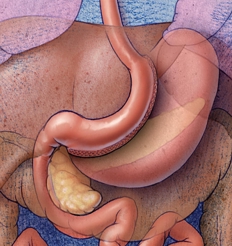 |
|
Weight Reduction Procedures Risk of Surgery Who Need Surgery Choice of Procedures Metabolic Surgery Life after Surgery |
LAPAROSCOPIC SLEEVE GASTRECTOMY
"Sleeve gastrectomy" or "vertical gastrectomy" is a new form of bariatric procedure in weight management. It involves removal of >75% of stomach and leaving a small gastric tube and this procedure resulting decrease in the stomach size inhibits distention of the stomach and increasing the patient’s sensation of fullness and decreasing their appetite. Some posit-increased satiety results from the decrease in production of an appetite hormone - Ghrelin, which secreted by the part of the stomach that was removed during surgery.  Expected weight loss: Usually loss ~50 – 70% of the excessive body weight in 2 years. (lack long-term >5 years data) Advantages:
Disadvantages:
|